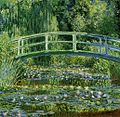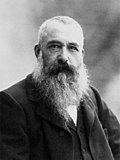English: Catalogue Entry:
Water Lilies and Japanese Bridge represents two of Monet’s greatest achievements: his gardens at Giverny and the paintings they inspired. Monet moved to Giverny in 1883 and immediately began to develop the property. For him, the gardens were both a passion and a second artistic medium. His Asian garden was not part of the original estate; it was located on an adjacent property with a small brook, which he purchased and enlarged into a pond for a water garden in 1893. He transformed the site into an inspired vision of cool greens and calm, reflective waters, enhanced by exotic plants such as bamboo, ginkgo, and Japanese fruit trees and a Japanese footbridge. It was not until 1899, however, that he began a series of views of the site, of which this is one.
A careful craftsman who reworked his canvases multiple times, Monet was committed to painting directly from nature as much as possible and for as long as he had the correct conditions; thus, he could work on as many as eight or more canvases a day, devoting as little as an hour or less to each. In this case, he set up his easel at the edge of the water-lily pond and worked on several paintings of the subject as part of a single process.
Monet’s gardens and paintings show the same fascination with the effects of time and weather on the landscape. Both are brilliant expressions of his unique visual sensitivity and emotional response to nature. At Giverny, he literally shaped nature for his brush, cultivating vistas to paint.
Gallery Label:
Water Lilies and Japanese Bridge represents two of Monet’s greatest achievements: his gardens at Giverny and the paintings they inspired. In 1883 the artist moved to the country-town Giverny, near Paris but just across the border of Normandy. This was a time when he was enjoying increasing financial success as an artist, and he immediately began to redesign the property.
In 1893, Monet purchased an adjacent tract, which included a small brook, and transformed the site into an Asian-inspired oasis of cool greens, exotic plants, and calm waters, enhanced by a Japanese footbridge. The serial approach embodied in this work—one of about a dozen paintings in which Monet returned to the same view under differing weather and light conditions—was one of his great formal innovations. He was committed to painting directly from nature as much as possible and whenever weather permitted, sometimes working simultaneously on eight or more canvases a day. Monet’s project to capture ever-shifting atmospheric conditions came to be a hallmark of the Impressionist style.





